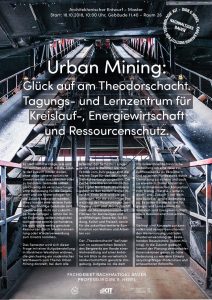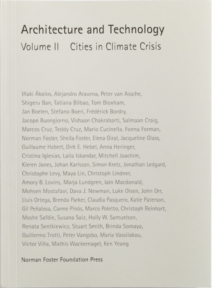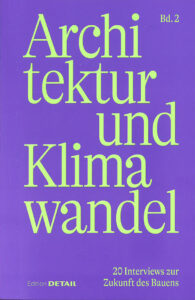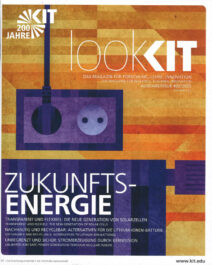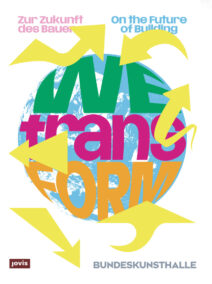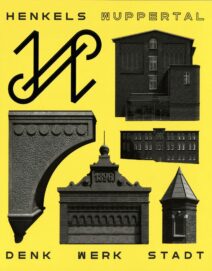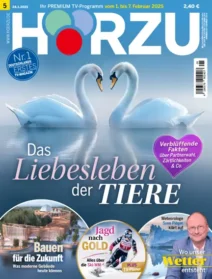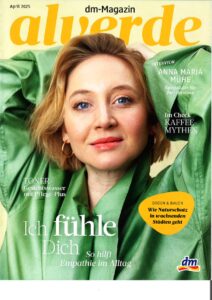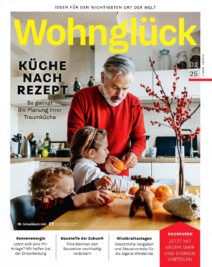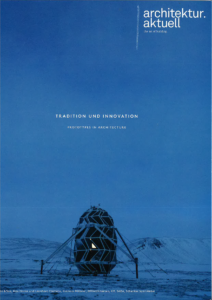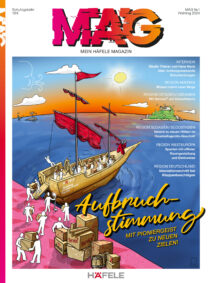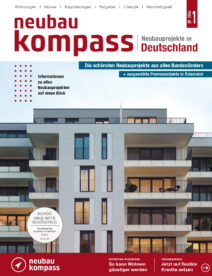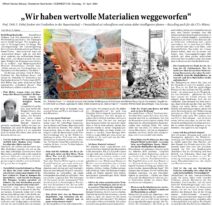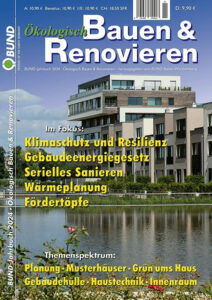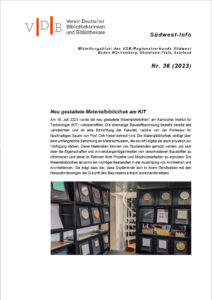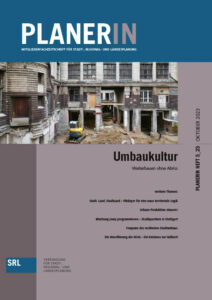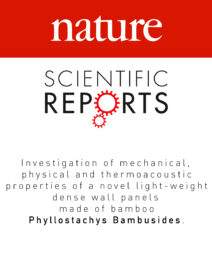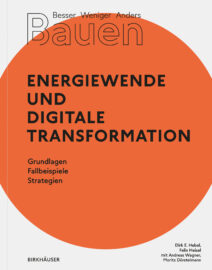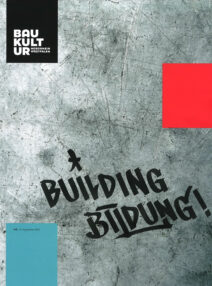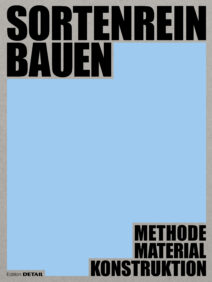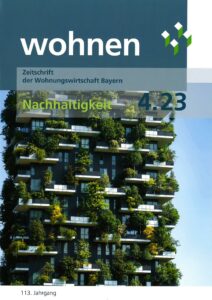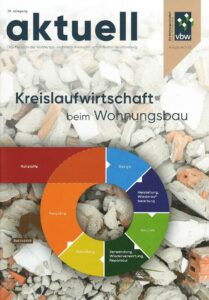Design Studios
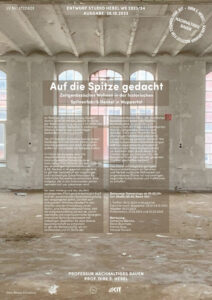
Winter Semester 2023/24 – Bachelor & Master
Design Studio Hebel: Thought to the point – Contemporary living in the historic Henkels lace factory in Wuppertal
As part of the Urban Mining Student Award 2023/24, visions for the sustainable use of existing buildings are being sought, both in the sense of redensification and in the sense of preserving important building culture in German cities. The KIT Faculty of Architecture has already won this competition three times in recent years and this year we want to take on the task again.
The focus of the task is the respectful conversion and cycle-compatible redevelopment of a historic factory site on the grounds of the former lace factory A.&E. Henkels in Wuppertal-Langerfeld. The task here is to develop an exemplary, viable and sustainable future concept for historic buildings. This is a task that will increasingly face us in the coming years.
Against the background of the significant increase in land consumption per capita and the increasing soil sealing of recent years, parallel to the urgent need for housing in the cities and the development of new living and working environment requirements, the task aims to develop innovative housing concepts with versatile qualities for a diverse population through spatial and organisational synergies.
The aim is to complement the residential use with a functional and constructively flexible range of spaces that can be used by third parties or adapted spatially, and to answer the design questions: What is “contemporary living and working”? How can a real social mix be generated within the former factory block? How can, for example, social housing and luxury apartments (necessary due to the financing model) co-exist or even create added value for all residents or for the entire district through their co-existence? The goal is to create a lively and flexibly usable residential area of appropriate density with high-quality, greened outdoor spaces and open spaces using as few resources as possible.
The design will take place in collaboration with the integrated disciplines of structural engineering (Prof. Riccardo La Magna)and building economics (Hon. Prof. Kai Fischer).

Winter Semester 2022 – Master
BauTechKIT – A laboratory for future building
The Faculty of Architecture and the Department IV Natural and Built Environment of KIT have set themselves the goal to become a pioneer of circular and sustainable building in Germany and Europe. This requires a new research, teaching and experimental laboratory for future building, in which research, teaching and practical applications can be interlinked and practiced.
Topics of sustainable building should not only be researched, but the building should already show and demonstrate them. The laboratory is to become a showcase for research into future building for the entire society and an attractor for the city of Karlsruhe.
The semester task is to develop a construction laboratory located in area 10 on the south campus. An urban planning study is part of the task. A large ground-level hall is required, in which new possibilities for future construction will be researched with the help of digital manufacturing processes and robotics, and experimental buildings will be erected. Above the hall, teaching and learning spaces for students and researchers are to be created with common zones for exchange and networking. On the roof area, individual research and innovation modules are to be installed according to the “plug-in” principle and can be dismantled again simply and easily. People will live and work in these changing units, so that they serve as busy experimental laboratories and at the same time shape and constantly change the appearance of the building.
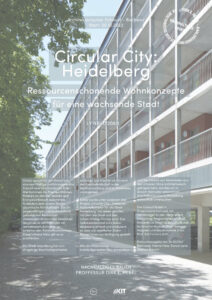
Winter Semester 2022/23 – Bachelor
Circular City: Heidelberg – Resource-efficient housing concepts for a growing city
Cities play a crucial role in the struggle for a sustainable and climate-friendly future. This is where housing, production, trade, transport and energy consumption all come together. In addition, our cities are gigantic stores of raw materials. In some areas, the resources tied up in the current building stock have long since exceeded the raw material deposits that can be reached with reasonable effort in the earth’s crust. This urban mine needs to be tapped.
The city of Heidelberg has set itself ambitious sustainability goals and wants to lead the way as a pioneer of the circular economy in urban development and urban planning. To this end, among other things, the project “Circular City – Building Material Cadastre for the City of Heidelberg” was launched, with which the city is relying on the urban mining principle. The building stock is being successively recorded and analyzed so that the data obtained can be made available to planners.
This semester, we will investigate how the application of circular building production and the use of materials from urban mining can succeed architecturally, using different design locations in Heidelberg.
The design will take place in collaboration with the integrated disciplines of structural engineering (Prof. Riccardo La Magna), FBTA (Prof. Andreas Wagner), and building economics (Hon. Prof. Kai Fischer).
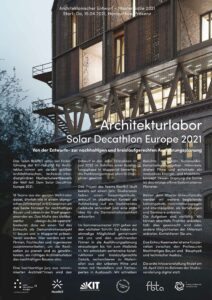
Summer Semester 2021 – Master
Architecture Lab – Solar Decathlon 2021
Team RoofKIT is taking part in what is currently the largest architectural, technical-interdisciplinary university competition in the world: the Solar Decathlon Europe 2021. 18 teams from all over the world are competing in 10 disciplines for the best concept for sustainable building and living in the city. The motto of the competition: “design-build-operate” means that we will build a part of the design as a demonstration object 1:1 and present it in Wuppertal.
The project of the RoofKIT team has already been running for a year. Students have developed an overall building design in an urban context as an addition to an existing building and have come up with an initial idea for the demonstration unit.
In the summer semester of 2021, we will take the next step: you will have the unique opportunity to join us and the executing companies, specialists and engineers in the execution planning up to a scale of 1:1. We will develop single-variety constructions and details that are appropriate for recycling, research materials from the urban mine, and enter into exchange with manufacturers and technical experts. We write reports, develop communication strategies, give interviews, shoot films and develop an innovative energy and mobility concept whose origin is the sun, the only open system on our planet.
The design semester is a cooperation between the professorships of Sustainable Construction and Building Physics and Technical Extension.
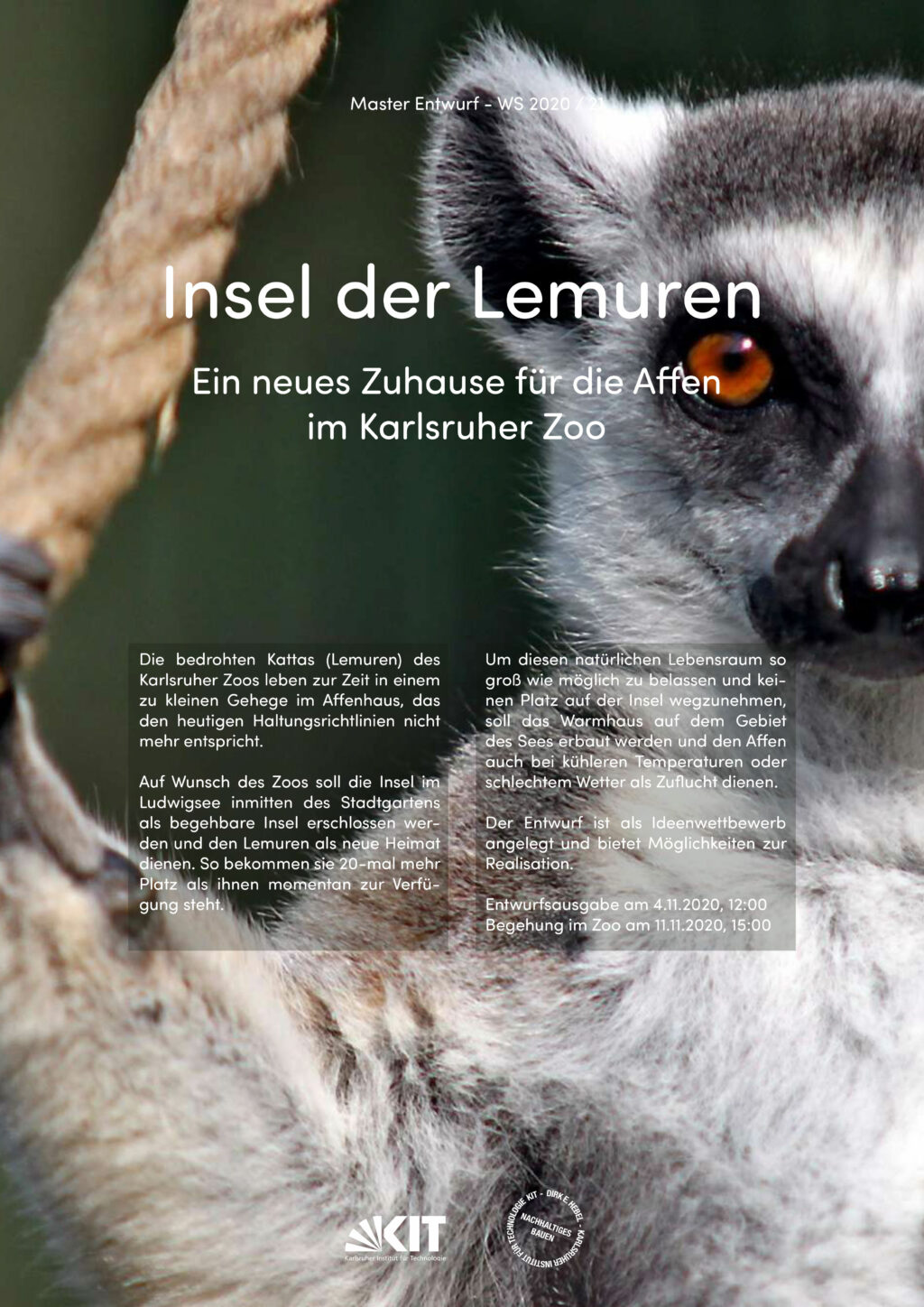
Winter Semester 2020/21 – Master
Island of Lemures – A new Monkey House for the Zoo Karlsruhe
The endangered Kattas (lemures) of the Karlsruhe zoo live in a small enclosure in the monkey house at the moment, that no longer corresponds to the recommended guidelines. At the request of the zoo, the Ludwigsee island in the middle of the Stadtgarten is to be developed as a walk-in island and serve as a new home for the lemures. This will give them 20 times more space than is currently available to them.
In order to keep this natural habitat as large as possible and not to take away any space on the island, the warm house will be built on the territory of the lake and serve as a refuge for the monkeys in cooler temperatures or bad weather.
The design is designed as an idea competition and offers possibilities for realization.
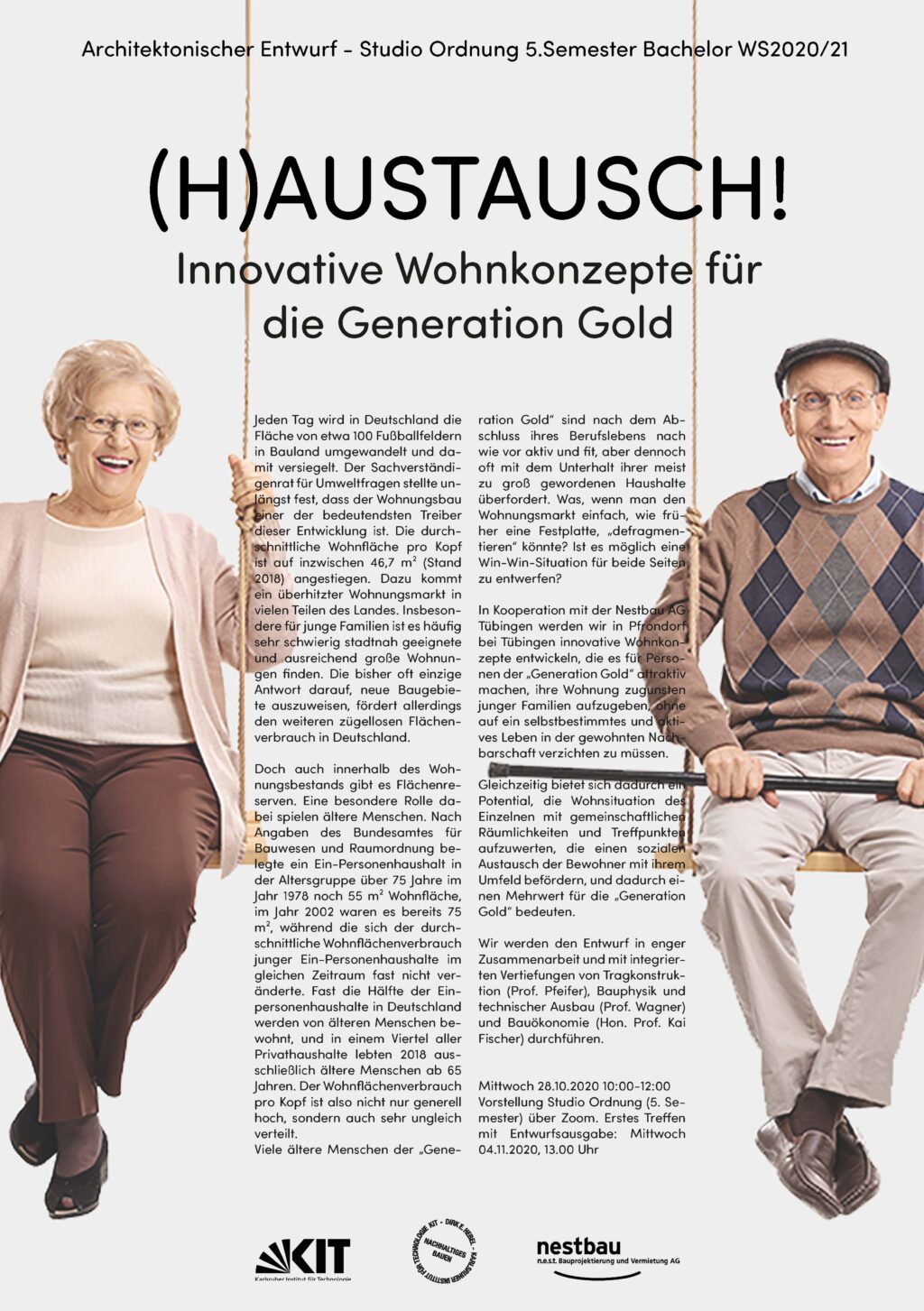
Winter Semester 2020/21 – Bachelor
(H)AUSTAUSCH! Innovative Living Concepts for Best Agers
In Germany the area of about 100 football pitches is converted into building land and thus sealed each day. The living space per capita has risen to 46.7 m². A significant role is played by elderly people of the “best ager generation”, who, after completing their working lives, remain active and fit, but are nevertheless often overburdened with the maintenance of their households, most of which have become too large. In contrast, young families often have difficulties finding suitable housing close to the city centre. New housing estates, which often seem to be the only answer to this problem, promote the continued excessive consumption of land in Germany.
In cooperation with Nestbau AG Tübingen, we will develop innovative housing concepts in Pfrondorf which will be appealing for “best agers” to give up their homes for the benefit of young families without having to give up a self-determined and active life in their familiar neighbourhood. At the same time this provides a potential to enhance the living situation of the individual with community spaces and meeting places that promote a social exchange between the residents and their neighbourhood, thus creating an additional value for the “best agers”.
Sommer Semester 2020 – Master
Renewable Up to 3 – Solar Decathlon Europe 2021
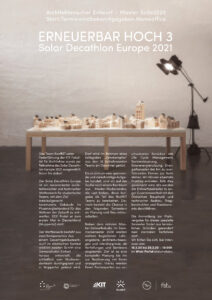
The building sector is one of the largest energy consumers in Europe and is responsible for around 36% of CO₂ emissions. In addition to the indispensable decarbonization of the building stock, ways must be found to meet the increasing need for affordable living space.
Densification has a great potential. Innovative interventions on existing buildings in particular can offer future-oriented perspectives. In the coming semester we will develop a top-up in the urban context of the Mirker Quarter in Wuppertal. For over 30 years, the Café ADA has been a center for sophisticated culture and a meeting point for artists, creative artists and guests of different nationalities. In this creative and colorful scenario, a roof top-up is to create space for innovative living spaces. Our largest available resource – solar energy – should form the heart of innovative energy concepts.
We also want to understand the city as a resource. In the sense of an urban mining strategy, design concepts are to be developed which, in line with a circular economy strategy, enable forward-looking architecture and CO₂-neutral construction. The social concerns of urban life are to be enriched with communal living spaces and sustainable concepts for urban mobility.
As Team RoofKIT, under the leadership of the KIT Faculty of Architecture, we were selected to participate in the Solar Decathlon Europe 2021. The topic of the semester is to translate this complex task with all its facets into a lively and sophisticated architectural design project.
The Solar Decathlon Europe is one of the most renowned architectural and construction competitions for student teams. In 2021 it will take place for the first time in Germany (Wuppertal). In a later step, a micro unit will be developed from your designs, which will ultimately be planned by the student team and built in Wuppertal. There, as part of a test phase in ten different disciplines, the winning design should be selected from 18 participating teams.
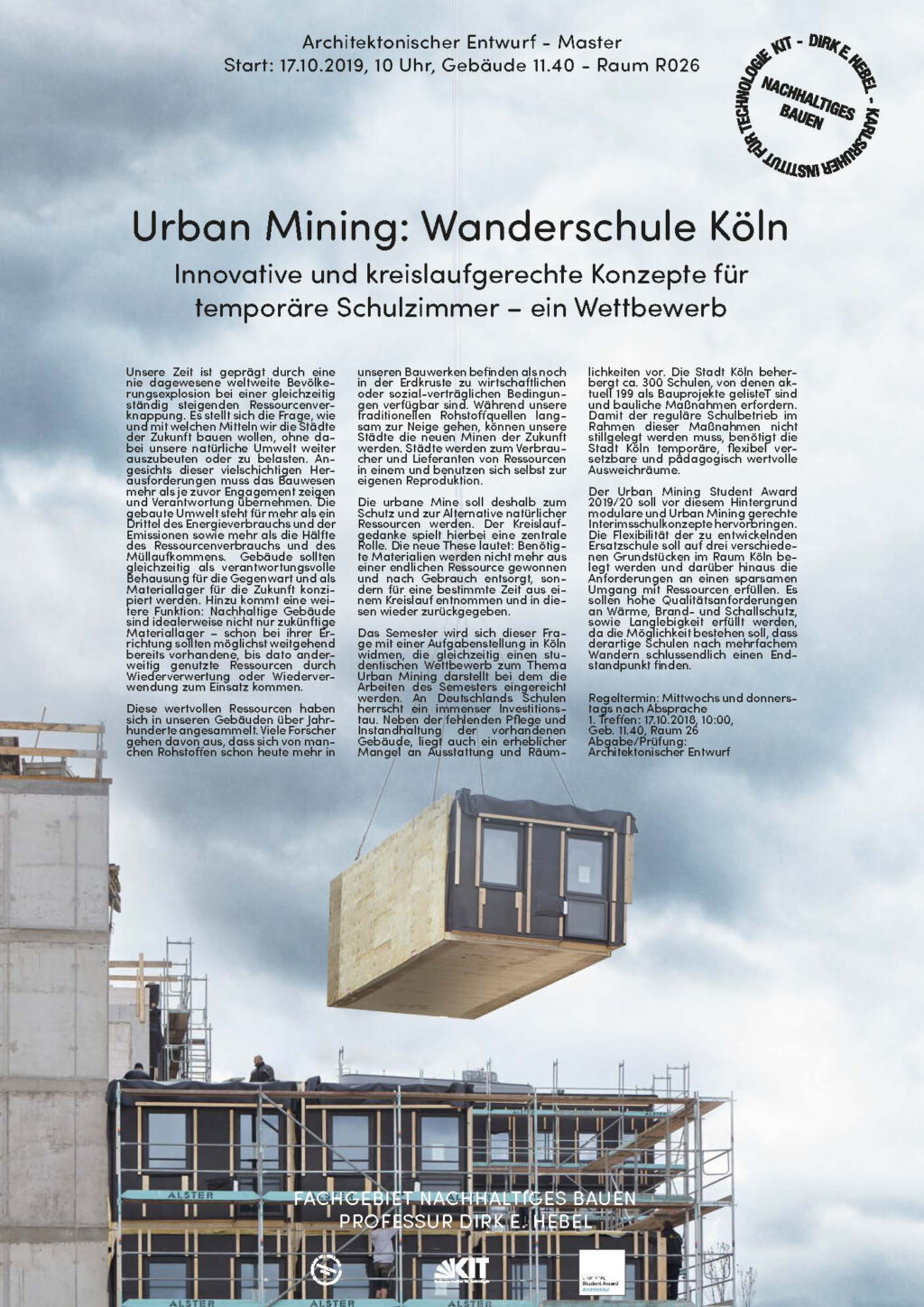
Winter Semester 2019/20 – Master
Urban Mining: Travelling School Project Cologne – A Competition
Our time is characterized by an unprecedented explosion of the global population and a simultaneously increasing shortage of resources. The question is how and by which means we want to build the cities of the future without further exploiting or polluting our natural environment. The urban mine should therefore become a way to protect and to an alternative to natural resources. Required materials will no longer be extracted from a finite resource and disposed of after use. Instead they will be taken out of an existing cycle for a certain time until they will be returned to it later on.
This winter semester, the students will face the task to plan a travelling school project for Cologne in order to cope with the immense investment backlog at German schools. The city of Cologne is home to approximately 300 schools, 199 of which are currently listed as building projects and require construction measures. In order to ensure the continuation of the school operations during these measures, the City of Cologne needs an alternative that provides temporary, flexibly relocatable and pedagogically valuable alternative rooms.
In this context, the Urban Mining Student Award 2019/20 is intended to produce modular and urban-mined interim school concepts. In order to ensure the flexibility, the alternative school will be located on three different sites in the Cologne area. It furthermore will need to meet the requirements of an economical use of resources and high standards for thermal, fire and noise protection as well as durability, as it should be possible for such schools to eventually find a location after several relocations.
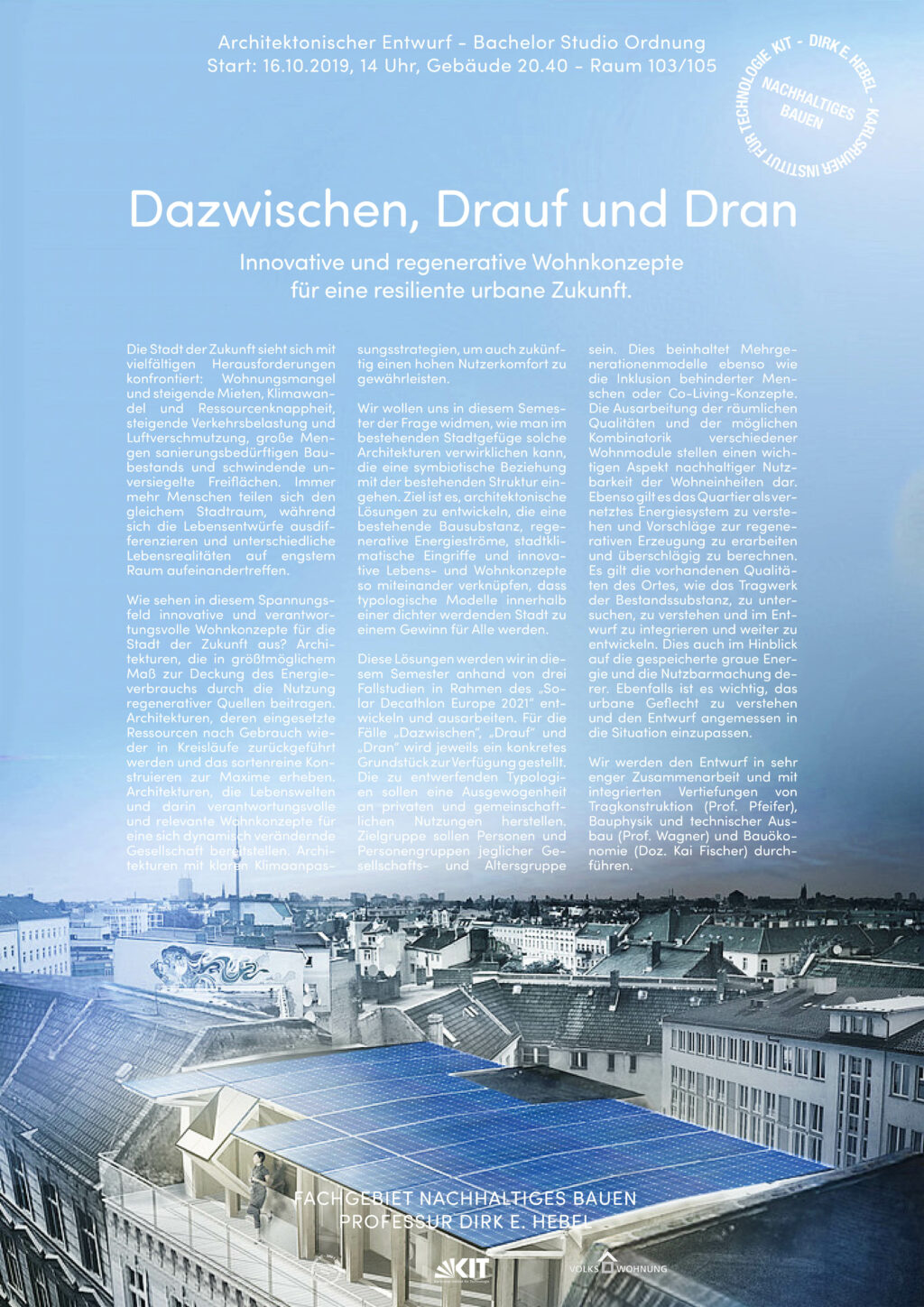
Winter Semester 2019/20 – Bachelor
In between, on top and aside – Innovative and regenerative living concepts for a resilient urban future
The city of the future faces many challenges: lack of housing and rising rents, climate change and scarcity of resources, increasing traffic and air pollution, large volumes of building stock in need of renovation, and dwindling unsealed open spaces.
What do innovative and responsible living concepts for the city of the future look like considering this special context. This semester, we want to focus on the question of how to realize such architectures that enter into a symbiotic relationship with the existing structure and urban texture. These ideas will be developed during this semester as part of the “Solar Decathlon Europe 2021”. The typologies to be designed should create a balance of private and community use. It is also important to understand the neighborhood as a networked energy system and to come up with proposals for regenerative energy concepts and calculate them roughly. It is the existing qualities of the place, such as the structure of the inventory substance to investigate, understand and integrate in the design and develop further.
The design is carried out in very close cooperation and with integrated deepening of structural design (Prof. Pfeifer), building physics and building technology (Prof. Wagner) and building economics (Doz. Kai Fischer).

Sommer Semester 2020 – Master
Kindergarten Cambodia
Approximately one third of the Cambodian population is affected by extreme poverty; 90 percent of them live in rural areas. That is where we will be working. 60 kilometers north of Phnom Penh lies the village of Mea Nork, 10 kilometers west of Odongk Airport in Cambodia.
The NGO “Smiling Gecko” has been operating there for several years. Its aim is to support people – most of them migrating from the slums of Phnom Penh – who want to come back to a self-determined life and a free and independent future. To this end, a community based on an agricultural economical system was started in 2014. The people help each other and use the collective as a reservoir for communication and exchange.
Since 2014, our professorship has supported “Smiling Gecko” in the construction of a school for 1,200 students for this community. The aim is to give the children growing up there the chance of an adequate and well-founded school education. Now “Smiling Gecko” has once again asked our professorship for help. The aim is to design, plan and build a kindergarten in the area.
In order to get to know the socio-cultural, ecological, economic and especially climatic conditions better, we undertake an excursion to Cambodia and to the building site near Phnom Penh at the beginning of the semester. The semester is conducted in cooperation with the professorships of structural design and building physics.
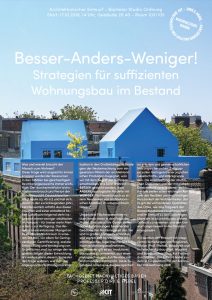
Wintersemester 2018/19 – Bachelor
Besser-Anders-Weniger!
Strategien für suffizienten Wohnungsbau im Bestand
Was und wieviel braucht der Mensch zum Wohnen?
Diese Frage wird angesichts immer knapper werdender Ressourcen in den Städten bei gleichzeitigem Bevölkerungszuwachs immer wichtiger. Der durchschnittliche Wohnflächenverbrauch pro Person der Bundesrepublik Deutschland beträgt heute ca. 45 m2 und hat sich damit in den zurückliegenden Jahrzehnten extrem erhöht. Aus dieser Situation und einer anhaltend hohen Landflucht folgernd steht insgesamt immer weniger städtischer Wohnraum – für immer mehr Menschen – zur Verfügung. Das Resultat ist ein eklatanter Mangel an bezahlbaren Wohnraum in unseren Städten, vor allem für Geringverdiener. Gentrifizierung, soziale Entmischung und Versieglung von Grünflächen sind nur einige der negativen Folgen dieser Entwicklung.
Wir wollen uns in diesem Semester der Frage widmen, wie man der angespannten Wohnungsmarktsituation in den Großstädten mit Strategien der Neubetrachtung vom eingesetzten Mitteln der architektonischen Produktion begegnet, was wir mit dem Begriff der Suffizienz umschreiben. Wie kann Wohnen BESSER gedacht werden, dass ANDERE typologische Modelle mit WENIGER Flächenverbrauch zu einem Neudenken von architektonischen Ansätzen im urbanen Raum führen?
Ungenutzte Flächenpotentiale rücken immer mehr in den Fokus der Planer. Eine attraktive Option stellen dabei Aufstockungen bestehender Gebäude der Nachkriegszeit dar. Sie sind in großen Mengen vorhanden und eignen sich hervorragend als prototypisches Experimentierfeld für Nachverdichtungsmaßnahmen.
Im Semester gilt es ein modulares Bausystem zu entwerfen, das einen mehrgeschossigen Auf/Neubau mit Wohnmodulen ermöglicht. Diese Typologien sollen eine Ausgewogenheit an privaten und gemeinschaftlichen Nutzungen herstellen. Zielgruppe sollen Geringverdiener jeglicher Gesellschafts- und Altersgruppe sein. Die Ausarbeitung der räumlichen Qualitäten und der möglichen Kombinatorik verschiedener Wohnmodule stellen einen wichtigen Aspekt der flexiblen und nachhaltigen Nutzbarkeit der Wohneinheiten dar. Es gilt die vorhandenen Qualitäten des Ortes, wie das Tragwerk der Bestandssubstanz zu untersuchen und im Entwurf zu berücksichtigen. Ebenfalls ist es wichtig das urbane Geflecht zu verstehen und den Entwurf angemessen in die Situation einzupassen.
Wir werden den Entwurf mit integrierten Vertiefungen von Tragkonstruktion (Prof. Pfeifer), Bauphysik und technischer Ausbau (Prof. Wagner) und Bauökonomie (Doz. Kai Fischer) durchführen. Der Entwurf findet zudem in Kooperation mit der Karlsruher Volkswohnung statt.
Wintersemester 2018/19 – Master
Urban Mining: Glück auf am Theodorschacht. Convention and learning center for circular economy, energy management and resource protection
Our time is marked by an unprecedented global population growth with a simultaneously increasing scarcity of resources. The question arises as to how and with what means we want to build the cities of the future without further exploiting or burdening our natural environment. The new thesis is: Required materials are no longer obtained from a finite resource and disposed of after use, but removed from a cycle for a certain time and returned to it later.
The semester will address this question within the design of a centre for the circular economy, which is also a student competition on urban mining, where the work of the semester will be submitted. The Ibbenbüren colliery in the northernmost tip of Nordrhein-Westfalen is one of the last two of its kind. It will be closed at the end of 2018. For the future development of the main facilities “von Oeynhausen” and “Nordschacht”, a master plan proposes areas for small-scale and large-scale industry, for education, culture and leisure, as well as for a future-oriented combination of living and working. The building substance should be extended or partially replaced. Concepts are needed for the meaningful and resource-conserving further use and / or reuse of the existing building substance (Urban Mining). Intended for the future, designing for disassembly is just as important as the use of recyclable materials and renewable raw materials.

Sommersemester 2018 – Bachelor
Tabakschuppen Hayna
Bis Ende des 20.Jahrhunderts prägte der Tabakanbau und die damit verknüpfte Industrie das ökonomische Umfeld und daraus resultierend das charakteristische Ortsbild der Gemeinde Hayna mit seinen 971 Einwohnern . Der Ort – als Straßendorf entwickelt – wird bis heute über seine ca. 100 Tabakschuppen geprägt. Doch diese einzigartige geschichtliche Charakteristik droht verloren zu gehen, bedingt durch wirtschaftlichen Wandel und nicht vorhandener Umnutzungskonzepte dieser Agrardenkmäler.
Die Bauwerke waren einst der Garant für die Trocknung riesiger Mengen Tabakblätter. Dabei musste gewährleistet werden, dass die Luft ungehindert durch die Seiten der Bauwerke zirkulieren und so der Trocknungsprozess eingeleitet werden konnte. Zuerst wohl nur als Dach konzipiert zum Schutz vor Regen, entwickelte sich im 19. und 20. Jahrhundert eine eigenständige Typologie mit immer raffinierteren technischen Maßnahmen. Zuerst wurden die Wände teilweise geschlossen, dann mit steuerbaren Klappen versehen und auch im Inneren wurden die statischen Holzstangengerüste der ersten Generationen durch mechanische Flaschenzüge und Metallständer abgelöst. Gleich geblieben ist jedoch die unverwechselbare turmartige Typologie. Da die Trocknungsschuppen zumeist in den hinteren zu den Feldern gelegenen kleinen Gärten der rechtwinklig zur Straße angeordneten Höfe gebaut wurden, geschah dies mit kleiner Grundfläche aber umso höheren Volumina, auch um die Durchströmung zu gewährleisten.
Mit dem Ende der EU-Tabakanbausubventionen in den späten Jahren des 20.Jahrhunderts brach jedoch der Tabakanbau in der Pfalz und damit in Hayna fast schlagartig zusammen. Zurückgeblieben sind die Bauten dieser Ära, die in den letzten 20 Jahren in einen Dornröschenschlaf gefallen sind. Aus Ermangelung an neuen Konzepten verschwinden immer mehr der typischen Bauwerke, da die Unterhaltskosten für Reparaturen den Nutzen für die Bevölkerung übersteigen. Erst in den letzten Jahren hat sich eine Interessensgemeinschaft in Form einer Bürgerstiftung gebildet um die charakteristischen Typologien zu erhalten. Aber was sind adäquate und dem Geist der Zeit entsprechende Nutzungskonzepte und Visionen für die Strukturen?
Dieser Frage möchten wir uns im Sommersemester 2018 widmen und gemeinsam mit der Bürgerstiftung Hayna gebaute Szenarien für das 21. Jahrhundert entwickeln. Wir werden erfahren, wie ein partizipatorischer Prozess mit der Gemeinde gestaltet werden kann, wir werden einige Tage im Ort dokumentarisch verbringen und wir werden gegen Ende des Semesters architektonische Lösungsansätze präsentieren, die als Grundlage für ein Umsetzungsprojekt dienen sollen. Welche Nutzungen schlagen Sie vor? Welche Umbaumaßnahmen sind dabei notwendig und sinnvoll? Wie erhalten Sie Teile der Strukturen und damit das Ortsbild? Wir verstehen das Studio als Experimental- und Testlabor, als Ideenschmiede und Gradmesser einer nachhaltigen Entwicklung von Baudenkmälern. Abhängig von der Qualität und Überzeugungskraft der Entwürfe und gleichzeitigem Interesse der Besitzer, ist eine weitere Entwicklung hin zum Bauprojekt angestrebt.
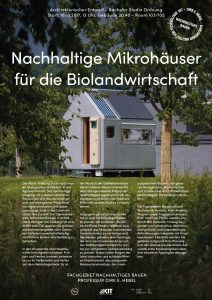
Wintersemester 2017/18 – Bachelor
Nachhaltige Mikrohäuser für die Biolandwirtschaft
Der Raum Freiburg sucht nach neuen ökologischen Leitbildern in der Agrarwirtschaft. Der nachhaltige Umgang mit unseren natürlichen Ressourcen und die nachhaltige und rein ökologische Produktion von Agrarprodukten sind dabei vorrangige Ziele in der Landwirtschaft der Zukunft. Der Demeterbetrieb Schmelzer&Siegel in Schallstadt-Mengen bei Freiburg hat sich daher zum Ziel gesetzt, die grösste zusammenhängende nach Demeterrichtlinien bewirtschaftete Agrarfläche in Baden-Württemberg zu betreiben.
In der Haupternte und Hauptbewirtschaftungszeit zwischen Frühjahr und Herbst, wohnen zeitweise bis zu 40 Helferinnen und Helfer auf dem Betriebsgelände. Es ist der Wunsch des Demeterbetriebs die Architektur dieser Unterkünfte dem übergeordneten Prinzip der nachhaltigen Agrarwirtschaft anzupassen und einen oder mehrere Entwürfe unseres Studios zu realisieren.
Insgesamt gilt es 20 Unterkünfte mit je zwei Schlafgelegenheiten zu planen, die entweder als kleine dörfliche Struktur oder als eine grössere aus Modulen bestehenden Gesamtstruktur zu verstehen sind. Sie werden gebeten eine Typologie, die dem beschriebenen Anspruch der Nachhaltigkeit entspricht, bis hin zur kompletten Detailausbildung zu planen. Dabei sollen Fragen der lokal sinnvollen und schadstofffreien Materialwahl, des adäquaten Ressourceneinsatzes, des kreislaufgerechten Bauens, der generell ökologischen, ökonomischen und sozialen wie auch ästhetischen Nachhaltigkeit im Vordergrund stehen.
Die Fachgebiete Bauphysik und Technischer Ausbau, Prof. Andreas Wagner sowie Tragkonstruktionen, Prof. Matthias Pfeifer werden uns durch das Semester hinweg begleiten und konstruktive, statische, energetische und nutzerbedingte Anforderungen integrativ mit Ihnen bearbeiten. Ebenfalls werden Sie gebeten aufgrund Ihrer Planung und des daraus resultierenden Aufwands erste Kostenangaben über Ihre einzelnen Typologien abzugeben.
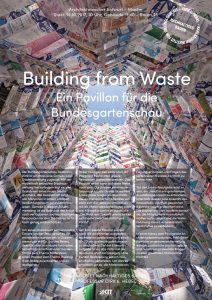
Wintersemester 2017/18 – Master
Building from Waste – Ein Pavillon für die Bundesgartenschau
Die Bundesgartenschau Heilbronn 2019 ist erstmals eine Garten- und Stadtausstellung zugleich. Mit der modellhaft bebauten Stadtausstellung Neckarbogen legt sie den Grundstein eines neuen Stadtquartiers, das beispielhaft zeigt, wie Menschen in einem urbanen Verdichtungsraum gut zusammenleben. Gerade in diesem Zusammenhang ist die Relevanz der Frage nach verfügbaren und nachhaltigen Ressourcen für den Städtebau nicht hoch genug einzuschätzen.
Um einen innovativen und sinnvollen Einsatz solcher Ressourcen zu demonstrieren entwerfen wir, in Zusammenarbeit mit Dr. Sascha Peters, dem Gründer von Haute Innovation, innerhalb einer Sonderfläche zum Thema Materialien einen Pavillon zum Thema Building from Waste. In der heutigen Zeit sollte Müll als integraler Bestandteil unserer Ressourcen betrachtet werden. Das Produkt selbst kann auf diese Weise, nach dem Durchleben eines ersten Lebenszyklus, als Quelle für weitere Erzeugnisse fungieren. Innerhalb dieses metabolischen Ansatzes versteht sich die gebaute Umwelt somit als Materialzwischenlager, oder wie Mitchell Joachim es ausdrückt: „Die Stadt der Zukunft unterscheidet nicht mehr zwischen Abfall und Vorrat“.
Der konzipierte Pavillon soll ein nach diesen Kriterien ausgewähltes Material zelebrieren, um einen 50-70 qm großen Ausstellungsort zu erschaffen. Ziel der Entwurfsaufgabe ist es, das Potential der Ressource Müll aufzuzeigen, ohne bei der Realisierung jedoch neuen Müll zu generieren. Um dies zu erreichen gilt es, die Materialwahl, Fügungsprinzipien und Fragen des sortenreinen Rückbaus kritisch zu betrachten.
Teil der Entwurfsaufgabe wird es sein, ein dem Ort entsprechendes Ausstellungskonzept zu entwickeln, innerhalb dessen eine Auswahl von innovativen, aus Müll gewonnen Baumaterialien präsentiert wird. Die Ausstellung zielt insofern darauf ab, die Möglichkeiten von Abfallstoffen aufzuzeigen und die Wahrnehmung dieses ‚erneuerbaren’ Werkstoffes zu verändern.
In einer hierzu vom Fachgebiet Architekturkommunikation, Prof. Dr. Riklef Rambow angebotenen Vertiefung werden zusätzliche psychologische und ausstellungsrelevante Fragen zu dem gewählten Material betrachtet.
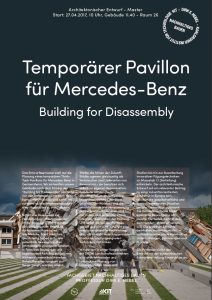
Sommersemester 2017 – Master
Temporary Pavilion for Mercedes Benz – Building for Disassembly
Das Semester untersucht die Planung eines temporären Think-Tank Pavillons für Mercedes-Benz in Germersheim. Wir entwerfen unsere Gebäude nach dem Prinzip des “Building for Disassembly”, um nicht nur den Aufbau sondern auch den kompletten Rückbau und somit die sortenreine Wiederverwendbarkeit aller Materialien zu ermöglichen.
Natürliche Ressourcen zur Herstellung von Bauten werden immer knapper – dies gilt selbst für vermeintlich im Überfluss vorhandene Materialien wie Metalle, Sand oder Kies. Gleichzeitig haben sich viele potentielle Ressourcen über Jahrhunderte in unseren Städten in Form von Bauwerken und sogenannten Abfällen aufgetürmt. Während unsere traditionellen Rohstoffquellen langsam zur Neige gehen, werden unsere Städte die Minen der Zukunft. Städte agieren gleichzeitig als Verbraucher und Lieferanten von Ressourcen – sie benutzen sich selbst zur eigenen Reproduktion. Gebäude werden heute allerdings kaum als temporäre Ressourcenspeicher der Stadt gesehen. Der Rückbau und die anschliessende Wiederverwertung der verbauten Materialien sind nur in den aller seltensten Fällen integraler Bestandteil der Planung. Und selbst da, wo der Rückbau gezielt geplant wird, scheitert eine ressourcengerechte Realisierung allzu oft an nicht recyclinggerechten Produkten und ungeeigneten Verbindungstechniken.
Wir werden in enger Kooperation mit SNOW Landschaftsarchitekten eine architektonische und konstruktive Planung von konzeptionellen Ideen und Studien bis hin zur Ausarbeitung innovativer Fügungstechniken im Massstab 1:1 (Vertiefung) entwickeln. Der architektonische Entwurf soll ein relevanter Beitrag zu einer zukunftsorientierten Baukultur in Europa sein, welcher die gesellschaftliche und ressourcenrelevante Situation unserer Generation aufnimmt. Die Semesteraufgabe bildet eine reale Bauaufgabe ab, welche Mercedes-Benz in den kommenden Jahren umsetzen will. Die erstellten Entwürfe beinhalten materialspezifische, architektonische sowie konstruktive Untersuchungen, Zeichnungen und Modelle. Die Professur bietet den Entwurf mit der bautechnischen Entwurfsvertiefung Konstruktion an. Ebenfalls bietet die Professur Matthias Pfeiffer die Möglichkeit einer Vertiefung im Bereich Baustatik an.

Fall Semester 2016 – ETH Zürich
Living Lab Zakynthos
We are designing a future-oriented, sustainable accommodation complex on the rural west coast of Greece. The ambition of the project, in conjunction with the Living Lab Hotel group future.camp, is to test how our future lives could be led in a world without consumption and destruction of natural resources. It is expected that the outcome of the studio will be realized by the client.
We develop the project based on your own definition of sustainability. The availability of resources, craftsmanship and talents as well as the climatic, ecological and economic conditions shall be integrated into the design of an innovative architectural project. The issue of contemporary tourism and its accompanying economic model will influence and inform your spatial concept. The scheme should consist of several pavilions, a lobby, administration building, educational facilities, as well as an infrastructural system for deliveries, supplies and sustainable disposal. You will be expected to work across a variety of scales, resolving individual buildings details as well as masterplanning.
We strongly recommend the seminar week “Venice – Reports from the Front” to all interested students offered together with the chair of Philippe Block. The chair offers the integrated discipline Construction within the course. Additionally, the integrated disciplines Architecture and Building Systems is offered under chair of Arno Schlüter. The course Life Cycle Assessment is also offered in collaboration with Roland Hischier (EMPA).

Spring Semester 2016 – ETH Zürich
Ressource Stadt – Building for Disassembly
We are planning 140 new apartments together with the Gemeinnützigen Bau- und Mietergenossenschaft Zürich (GBMZ) in District 4 in Zurich. We design our buildings according to the principle of „building for disassembly“ in order to allow not only their construction but also the complete dismantling and hence the genuine reusability of all materials.
In close collaboration with Werner Sobek and the Institut für Leichtbau Entwerfen und Konstruieren (ILEK) at the Technical University of Stuttgart, we will develop an architectural and constructional approach ranging from urban issues to the formulation of innovative jointing techniques in full scale. The architectural design should be a relevant contribution to a future-oriented building culture in Europe, which adresses the social and resource-related situation of our generation. The semester task represents a real construction project, which will be implemented by the GBMZ in the coming years. The cooperative will accompany the semester.
We strongly recommend the seminar week “Zukunft des Bauens” (future of construction) to all interested students.

Fall Semester 2015 – ETH Zürich
Cambodia: Village School Project
We are planning a school in rural Cambodia within an existing village structure about two hours north of the capital Phnom Penh. The school consists of several classrooms, a cafeteria, an auditorium as well as medical and infrastructural buildings.
In addition to these specific social conditions, the availability of material resources, talent and technical skills as well as the climatic, ecological and economic conditions have to be considered in the design. The question of contemporary didactical concepts and their spatial implementation is an important issue in the semester. Together with local professionals we will develop a reasonable and customized strategy how the school system and the necessary infrastructure can be implemented in several phases. The client considers the realization of the project.
We also offer a seminar week on this subject to interested students. Participation is strongly recommended but not mandatory.
Spring Semester 2015 – ETH Zürich
Resource Schweiz / Architektur 1:1
Whereas the architectural typology of a vacation home mainly demands relations to the attractive and spectacular surrounding landscape, the atelier focuses inwards. The “genius loci” cannot be found in the surroundings, but in the architectural form, in functional standards, architectural finishing in materiality and in the atmosphere out of it, in principles of construction and in solutions of details. However, both types of construction – vacation home and atelier – are of moderate dimension. In discussions with craftsmen this dimension is to be defined; knowledge and skills are not only instruments for construction, but should define the design strategy in order to find an unique identity.
The course applies the same principles as currently used in the Design Semester in Ethiopia, investigating similarities and discrepancies in two extremely contrary places.

Fall Semester 2014 – ETH Zürich
5000 Housing Units for Addis Ababa
Urbanization is generally seen as a positive factor in poverty reduction, however it requires careful urban planning strategies and innovative housing designs, which capitalize on local resources and practices. Efforts to do so have largely failed in the fast growing cities of Africa. Rather than enhancing the value of existing local resources and practices by combining them with innovative approaches and mechanisms for planning, governments prefer to import foreign typologies in a formal top-down process. Here, unfortunately, Ethiopia is no exception. Besides its strong efforts concerning future urban development, Ethiopia is missing a strong national urban housing strategy to address the incredible housing shortage together with the overwhelming poverty rate of its inhabitants.
The Grand Housing Development Program forced hundred thousands of people out of their original neighbourhoods, cutting all ties to their social networks. Kids had to leave their schools, and parents lost their local market to sell small, hand-made products. The new shelters, which they are allocated to, are far from the city centre, making it impossible for people to keep in contact. Finally recognizing this dilemma, the city administration recently commissioned the Ethiopian Institute of Architecture, Building Construction and City Development EiABC and the Chair of Architecture and Construction Dirk E. Hebel of ETH Zürich to design 5000 housing units in the inner parts of the city, where people can reside while their original neighbourhoods are demolished and replaced by new condominiums of the Grand Housing Development Program.
